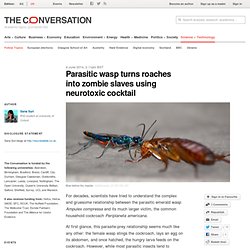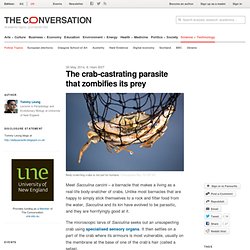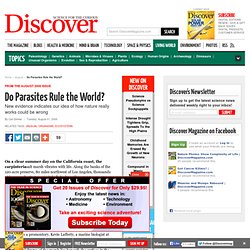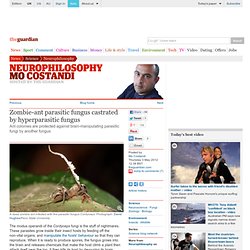

Parasitic wasp turns roaches into zombie slaves using neurotoxic cocktail. For decades, scientists have tried to understand the complex and gruesome relationship between the parasitic emerald wasp Ampulex compressa and its much larger victim, the common household cockroach Periplaneta americana.

At first glance, this parasite-prey relationship seems much like any other: the female wasp stings the cockroach, lays an egg on its abdomen, and once hatched, the hungry larva feeds on the cockroach. However, while most parasitic insects tend to paralyse their victims with a venomous sting, the emerald wasp instead manipulates the cockroach’s behaviour, essentially transforming it into a zombie slave. The crab-castrating parasite that zombifies its prey. Meet Sacculina carcini – a barnacle that makes a living as a real-life body-snatcher of crabs.

Unlike most barnacles that are happy to simply stick themselves to a rock and filter food from the water, Sacculina and its kin have evolved to be parasitic, and they are horrifyingly good at it. The microscopic larva of Sacculina seeks out an unsuspecting crab using specialised sensory organs. The 7 Most Horrifying Parasites on the Planet. As soon as your doctor says you've got parasites in your body, you don't need to hear any more details.

They're all horrible, right? How can it get worse than little tiny worms or something feeding on your insides? Actually, it can get way, way worse. As it turns out, there's nothing in nature more creative than a parasite. And we don't mean that in a good way. The Guinea Worm Will Make You Do Its Bidding Technically, your body is full of tiny creatures already. This brings us to the guinea worm. So you go swimming and the flea makes its way down your throat. And growing. About a year after infection, the full sized guinea worm is no longer microscopic, but instead measures two to three goddamned feet long.
Being so large, a cramped human body is no longer adequate real estate. This is exactly what the worm wants. Do Parasites Rule the World. On a clear summer day on the California coast, the carpinteriasalt marsh vibrates with life.

Along the banks of the 120-acre preserve, 80 miles northwest of Los Angeles, thousands of horn snails, their conical shells looking like miniature party hats, graze the algae. Arrow gobies slip through the water, while killifish dart around, every now and then turning to expose the brilliant glint of their bellies. Fiddler crabs slowly crawl out of fist-size holes and salute the new day with their giant claws, while their bigger cousins—lined-shore crabs— crack open snails as if they were walnuts. Mysterious Asian corpse flower parasite actually steals huge chunks of its host¿s DNA but what does it do with it?
'Eureka' finding rewrites relationship between parasite and hostScientists puzzled over WHY flower 'steals' genesParasitic plant cannot live without its host By Rob Waugh Published: 11:26 GMT, 7 June 2012 | Updated: 11:26 GMT, 7 June 2012 A corpse flower in Sarawak, Malaysia: The 'corpse flower' - a parasitic plant which lives in the jungles of Borneo does something far more sinister than simply living off its host.

Zombie-ant parasitic fungus kept in check by hyperparasitic fungus. A dead zombie ant infested with the parasitic fungus Cordyceps.

Photograph: David Hughes/Penn State University The modus operandi of the Cordyceps fungi is the stuff of nightmares. These parasites grow inside their insect hosts by feeding off the non-vital organs, and manipulate the hosts' behaviour so that they can reproduce. When it is ready to produce spores, the fungus grows into the brain and releases chemicals that make the host climb a plant then attach itself near the top.
It then kills its host by devouring its brain, before sprouting a mushroom from the top of its head, which disperses its spores as widely as possible. Cordyceps fungi can decimate entire ant colonies, but some colonies can keep an infestation at bay and survive for long periods of time. Cordyceps manipulate worker ants to leave their nest and march off to a nearby site where they will eventually meet their fate. Sandra Andersen of the University of Copenhagen and her colleagues took advantage of this. Hidden Epidemic: Tapeworms Living Inside People's Brains. Theodore Nash sees only a few dozen patients a year in his clinic at the National Institutes of Health in Bethesda, Maryland.

That’s pretty small as medical practices go, but what his patients lack in number they make up for in the intensity of their symptoms. Some fall into comas. Some are paralyzed down one side of their body. Others can’t walk a straight line. Still others come to Nash partially blind, or with so much fluid in their brain that they need shunts implanted to relieve the pressure.
Underneath this panoply of symptoms is the same cause, captured in the MRI scans that Nash takes of his patients’ brains. A blob in the brain is not the image most people have when someone mentions tapeworms. “Nobody knows exactly how many people there are with it in the United States,” says Nash, who is the chief of the Gastrointestinal Parasites Section at NIH.